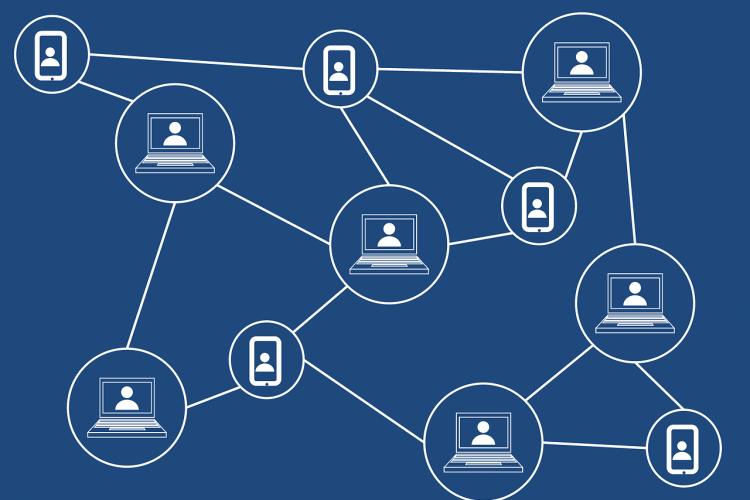Network Infrastructure
What is a Network Architecture?
In Information Technology, the term network means at least two computer systems connected by either a cable or a wireless connection.
The simplest form of the network consists of two computers connected through a cable. This is called a peer-to-peer network.
There is no hierarchy in this kind of network, and both systems have equal access rights. Each computer system can access data of the other system and can also share resources such as disk space, applications, and peripheral devices.
Today’s networks are a bit complex and consist of many computers linked to each other. Systems with more than ten computers usually use client-server networks. Here, a central computer system known as a server provides resources to all other connected systems in the network; they are known as clients.

What are the tasks of a network?
The main task of a network is to provide all clients (individual computers or devices) with a single platform for exchanging data and sharing resources. This task enables the smooth functioning of everyday life in a modern world and it would be not possible without networks.
The network is useful when a project needs to be done by many teams and each team needs to access data from a central resource and also contribute to the resource that others can find useful. Without networks, it would be impossible to update any resource in real-time and it would also be time-consuming.
Advantages of networks:
- Sharing of data across teams/departments
- Sharing of resources across teams/departments
- Central control platform of data, apps, and programs
- Central storage of data
- Central backup of data
- Shared processing power and storage capacity
- Easy access & management of authorizations and responsibilities
Components of a Network System:
A typical network has 5 basic components, namely clients, servers, channels, interface devices, and operating systems.
Servers: Servers or Host computers are powerful computers that store data or applications and all the resources that are shared by other users within a network.
Clients: The client is the individual computer used by the users within the network to access the servers for shared resources (such as hard disks and printers). Thus any personal computer or peripheral device such as a printer is a client.
Channels: Channels are known as network circuits. It is the pathway over which information/data travels between the different computers (clients and servers) that comprise the network.
Interface devices: The devices that connect clients and servers to the channel are called interface devices. Modems and network interface cards are common examples.
Operating systems: This is the software that runs the Network systems. It serves the same purpose as any normal computer. It provides the user interface for accessing the data and resources.

What is a Passive Network?
A passive network is one of the most common types of network. It requires pre-designing and configuring the entire network infrastructure before any operation.
A node in the passive network will only perform actions that are configured within it. When packets of data are transferred over a passive network, they can only transfer the data and not process it.
Passive Network Hardware includes:
- Cables (fibre optic cable, coaxial cables)
- Connectors.
- Switchboards.
- Clutches.
- Plugs.
What is Active Network?
Active networking means that packets of data flowing through a network can dynamically modify the operation of that network.
It consists of hardware that supports switching or routing along with executing a code within active packets over the network.
Active Network Hardware includes:
- Switches.
- Repeater.
- Hub.
- Bridge.
- Routers.
- Print Servers.
- Access points (AP)
- Power E-Net.
Active network components include elements and/or devices that are capable of providing or delivering energy in the circuit. Passive network components are only capable of storing energy in the form of current or voltage in the circuit
Differences between Active and Passive Network Components
Functions | Active components | Passive Components |
Energy use | Can produce and deliver energy in the form of current or voltage | Can only utilize and store energy in the form of current or voltage |
Power Gain | Capable of providing power gain | Not capable |
Flow of Current | Can control the flow of current | Cannot control the flow of current |
Energy | Energy donors | Energy acceptors |
Power source | Require an external source | Do not require an external source |
Examples | Diodes, transistors, integrated circuits, Silicon-controlled rectifiers, etc. | Resistors, capacitors, inductors, clutches, plugs, etc. |
Below are some of the Network Infrastructure we built for our clients.






Why choose Red Circute India Pvt Ltd?
- Assess your network needs
- Build and integrate old systems into the network
- Regular maintenance of networks
- Setup network security
- Quick response customer service
- Budget friendly
- Free consultation
Can Red Circute help us set up our Network Infrastructure?
We have expertise in setting up Network Infrastructure for our clients. We build both passive and active networks for your office, commercial establishment, and industry.
Fix an appointment today to know how we can proceed forward.
